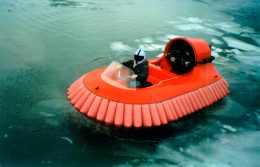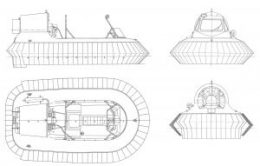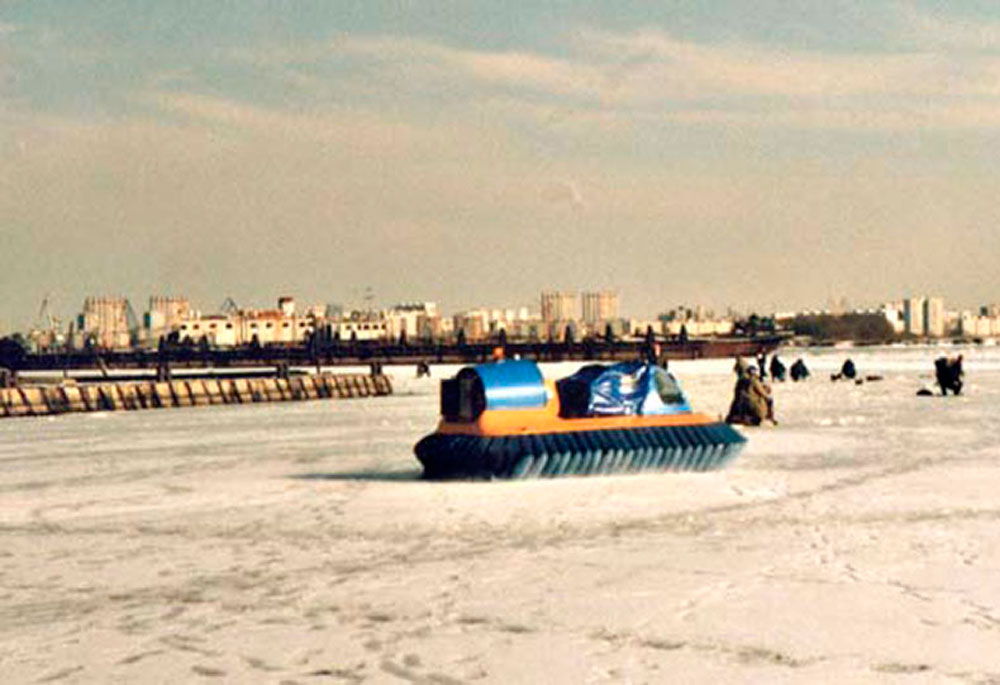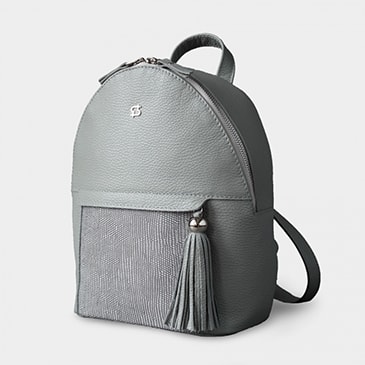2 persons
Description

The boats are produced only in batches for one customer.
High-speed amphibious hovercraft Neptune 3 “Sobol” is designed to carry 150 kg of cargo or up to 2 passengers. The hovercraft belongs to the class of “sports and entertainment” hovership and is designed to get pleasure from fast driving on water bodies in summer or winter, including short-term going ashore and rolling back. The boat is able to overcome smoothed ledges up to 60 cm high and not smoothed – up to 20 cm. The boat is capable of reaching a speed of about 70 km / h on water.
The hull
The hull is made of fiberglass. Structurally, it consists of two parts: the outer hull and the deck. The shape of the outer case is a flat bottom with rounded sides along the entire perimeter. The strength of the structure is provided by the required sheathing thickness and additional reinforcements. The hovercraft remains buoyant when the engine is off due to its waterproof housing.
Salon
The hovercraft salon is made without a superstructure. In the center, along the hull of the vessel, there is a longitudinal seat with a locker on which the navigator and passenger are located. A splash-proof windscreen is installed in front of the boatmaster. Longitudinal handrails are installed along the sides of the hovercraft. The Hovercraft is equipped with a white all-round fire and an orange flashing light. Upon request, it is possible to manufacture a superstructure with a fiberglass bow and an awning in the stern.
Engine

One ROTAX-582 with a power of 64 hp is installed as the main engine on the hovercraft. The piston engine ROTAX 582 Model 99 is a gasoline, two-stroke, two-cylinder, in-line arrangement of cylinders, with a liquid cooling system, with a rotating disc valve for intake control, with an electronic duplicated ignition system, with carburetor mixture formation.
The engine is equipped with a resonant type exhaust system. The engine starting system can have a manual and / or electric starter. An integrated 12-pole generator provides engine ignition and electrical system operation. The engine has four threaded rods on the bottom of the crankcase for attachment to the engine mount. The engine resource before the first overhaul, as well as the overhaul life – 300 hours.
The warranty resource is 100 operating hours or 6 months from the date of the first launch, or 1 year from the date of purchase. To monitor the operation of the engines, a tachometer and a coolant temperature sensor are installed in the control panel. The engine is installed in the aft part of the hull in front of the propeller. A single-stage gearbox is installed on the engine to reduce the speed of the propeller shaft relative to the speed of the crankshaft. The torque from the gearbox is transmitted directly to the screw. The hovercraft has a 23 liter fuel tank. Fuel consumption at maximum speed is approximately 20 l / h.
Flexible fencing
The hovercraft adopted a single-tier flexible fence with removable elements along the entire perimeter, without a flexible receiver. The role of the receiver is played by the space between the hull and the deck. The sector air intake behind the propeller plays the role of the air cushion blower.
Every second in the air flow, it supplies air under pressure to the receiver, which directs it through a multitude of holes to the removable elements. Air then exits through the lip between the removable element and the surface. This scheme allows removable elements to remain elastic. Those. when passing obstacles, flexible elements deflect and let the object pass under them without trying to resist it. Only the lower segment tier, which consists of many independent elements, participates in contact with the surface. Each element is attached to the receiver with four clips. Replacement is simple and does not require special tools and skills; carried out in 3-5 minutes.
Due to the constant air flow in the airspace in dash air bubble, the flexible fencing retain the ability to move the hovercraft even if all removable elements are lost.
The flexible fencing material – rubberized fabric based on rubber nylon. This fabric allows you to expand and take a given shape in low temperatures.
Air bubble propellers and blowers

The hovercraft is equipped with one 12-blade fixed-pitch propeller with a diameter of 850 mm in an aerodynamic nozzle. Blade material – fiberglass. A block of air rudders is installed behind the propellers on aerodynamic nozzles. Air rudders are controlled by turning the motorcycle-type steering wheel. Air rudders create a steering moment in the nose area. The change in roll and trim is carried out by moving the weight of the boatmaster’s hull.
Other
Hovercraft is equipped with life jackets, engine control devices, fuel tank, electric starter, exhaust muffler.
SPECIFICATIONS
Main dimensions and characteristics
| Overall length of the hull, m | 4.0 |
| Extreme breadth of the hull (with hinged sections), m | 2.0 |
| Cushion height (clearance), m | 0.2 |
| Passenger-carrying capacity, people | 1-2 |
| Minimum crew, people | 1 |
| Payload, t | 0.17 |
| Service speed (on water), km / h | 45 |
| Maximum speed (on water), km / h | 65 |
| Service speed (on ice), km / h | 50 |
| Fuel reserve, l | 20 |
| Total fuel consumption, l / h | 20 |
| Endurance of fuel reserve, h | 1 |
| Safe wave height, m | 0.2 |
| Supervision | STATE INSPECTION OF SMALL VESSELS (SISV), ship of special design (THE HOVERCRAF) |
Engine
| Engine type | Two-stroke two-cylinder ROTAX-582UL |
| Power | 65 h.p. (48 kW) |
| Maximum RPM | 6500 rpm |
| Working volume | 580 cubic cm |
| Compression ratio | 11.5:1 |
| Fuel system | gasoline, carburetor |
| Specific fuel consumption | 425 g / kWh |
| Cooling system | Liquid |
| Motor maintenance weight | 29.1 kg |
 Youtube
Youtube




